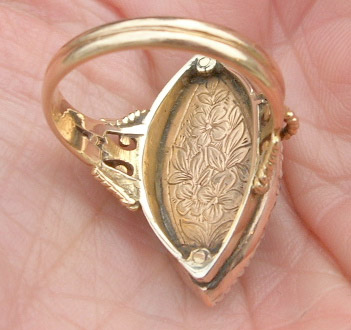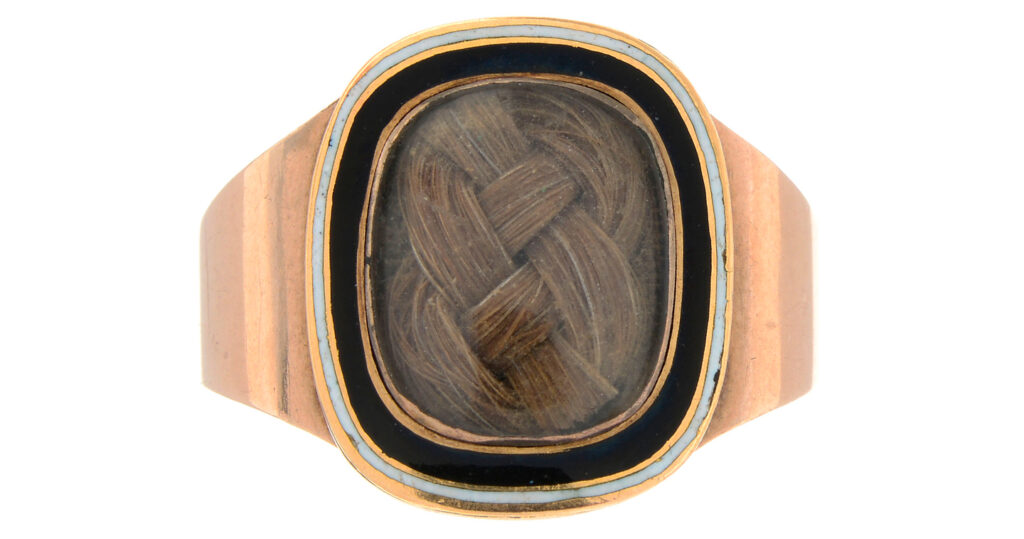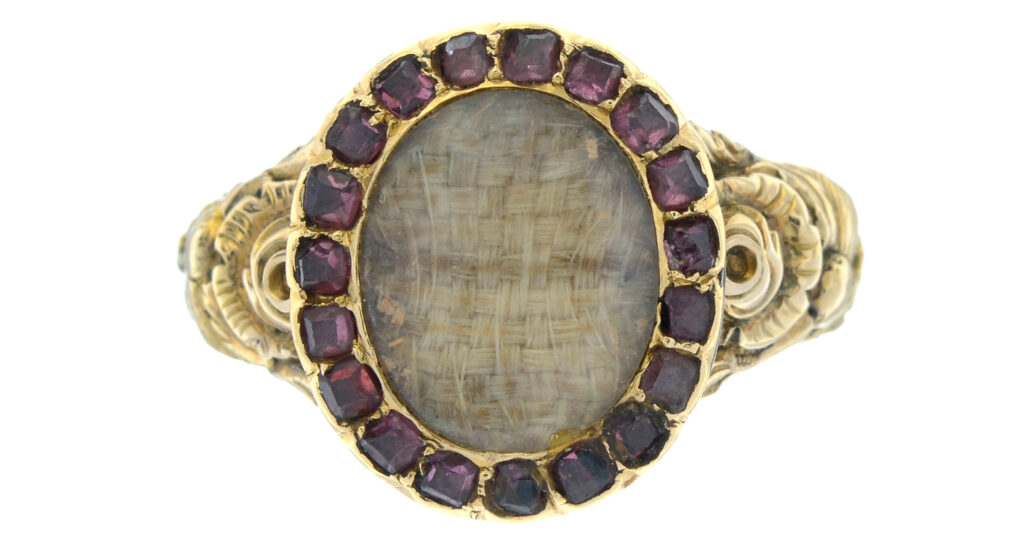Diamond Navette Ring, Late 18th Century
The combination of blue enamel and diamonds aren’t a coincidence, there are intrinsic links in their symbolism and meaning that work in conjunction with each other and that is why you may see many of these combinations, but never are they in any way common.
This ring is one of the most elegant love tokens of its time, it utilises symbolism and form in design to produce a jewel which is as effective as a fashionable and beautiful object that has never really left mainstream fashion. Much of this is to do with its central theme of the flower. Flowers in love symbolism for modern society have been popular tokens of affection from the middle ages and that still remains true today. Using the motifs within a jewel take the physical element of the flower and encapsulate it forever within something which can be worn.
Upon the front, we have the forget-me-not, a symbol that, I’ve written quite a bit about in its own Symbolism Article, however, I’ll abridge some of the text and use what is needed to put this ring into context:
“Forget-me-not, O Lord!” is what a poor German knight shouted as he fell into a river. He and his lady were picking flowers by the side of the river at the time, no doubt enjoying the beautiful day around them, and yet as fate would have it, the knight’s armour dragged him down to the bottom as he fell in. Upon his cries to the Lord, he threw the blue posy of flowers to his loved one and promptly drowned. This little tale reportedly dates to around the 15th century, but no doubt had different permeations along the way, as romantic stories often do. Hence, the concept of remembrance, eternal love and faithfulness grow from this.
Now that we have the tales out of the way, the symbolism of the forget-me-not is obviously implied within its name. It should also be noted that the flower grows quite ubiquitously in Europe, America and Asia. Its first use in English literature is reportedly from c.1532 and is otherwise named Myosotis (mouse’s ear). Interestingly enough is the rise of the flower’s popularity c.15-16th centuries. This is what we, as jewellery historians, need to understand. From this, we have the popularity of the posy ring and its use as a love token in jewellery. The posy (poesy, posie, posey) emerged at a time when modern society was developing through a shift back to the personal and emerging from the middle ages and its strict adherence to ecclesiastical living. Giving a ring with an inscription on the inside as a token of love was a profound statement, it showed that relationships were increasingly interpersonal and not decreed before god. It was between the couple. Hence, the forget-me-not was used as a decoration (often crude) in some of these rings to denote its message of love and remembrance.
During the 17th and 18th centuries, the use of the forget-me-not didn’t change, however, it did blend in well with the Rococo and Baroque excess of design well enough that it could balance with other flowers and leaf motifs. By the time of the Neoclassical period, its use was relegated more towards being a footnote in memorial jewel depictions painted on ivory. During this time and the rise of hairwork weaves becoming mainstream and popular, the forget-me-not did become a symbol used to create floral depictions from hair.
The 19th century is when the forget-me-not truly found its place as a central motif. Many rings, bracelets, brooches and mourning/sentimental peripherals showcased the forget-me-not as a primary motif, often boldly displayed on enamel. Often, other symbols (buckle/belt/serpent/cross) would complement the forget-me-not, rather than it being a symbol used as a design flourish or in repartition. Where the flower was used in more decorative areas of jewellery was in the Rococo Revival period, especially the latter 19th century, and lasted into the 20th century with its reliance on its romantic roots. Its use in the 20th century became much softer; in the Edwardian period, the romantic movement adopted the symbol and applied it (often in enamel) to lockets and by the time of the First World War, its relation to the remembrance of soldiers (carried through by poetry) and into the Second World War was assured.
With this ring, the diamonds are embedded throughout the forget-me-not itself and the vessel that it’s placed within. There is an indication here that it’s the “heart” and the forget-me-not is forever within the “heart”, hence the person who commissioned this piece would ensure that the ring is a reminder to the wearer that they are never from their heart.
Diamonds surround the navette shape as well and also the blue enamel is used to demonstrate that the wearer was considered to be royalty. Truly a grand statement for anyone to dedicate to another.
Upon the back of the recessed is even more interesting. It’s completely adorned with the floral motifs, which work in conjunction with the front. This is a most unusual style, as why would there be a necessity to engrave an area which would essentially be worn down? Often with mourning jewels, the name and dates are written on the back, but here we have a clear design that was considered when the ring was made.
Truly a grand piece for any age, this ring shows every element of beauty and sentimentality.
Further Reading
> Blue Enamel, Diamond Mourning Ring, 1797
> Blue Enamel and Diamond Family Mourning Ring, Late 19thC
> Grand Tour 2011: Treasure from Abroad (Part 1)
> Amazing Georgian Diamond Urn Ring
> 18th Century Diamond Fede Ring








